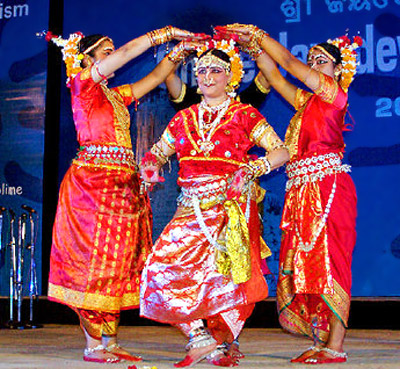 Abhinayaka is an ancient Indian treatise on Odissi dance. It was written by Maheswar Mohapatra under the royal patronage of Sriman Narayan Deva of Khemundi kingdom in 15th century A.D. This text contains 284 verses. The first two verses are in praise of Ganapati and Lord Jagannath. Till the 18th verse, the author gives an account of Nrutya Prasansa and then he describes the origin of Odissi dance. The author has vividly described the Pada Mudras of the Odissi dance. According to him there are four are basic positions of the feet Stambha Pada (Samapada), Kumhhapada (Ayatamandalapada), Dhanupada and Mahapada. Then he has enumerated Sama, Bisama, Ghatita (Udghatita) Suchi and Agratala Sanchara. The author of Abhinaya Chandrika has described only sixteen Mudras with different names. He has described twenty eight Hasta Mudras. He goes on to give a detailed description of the Bandhas (acrobatic poses) of Bandha Nrutya. Other things which find mention in the text are Sapta Tandava of Lord Shiva, dances of different regions, folk dances of Orissa, Bhumis, Charis, Karakshetras, Mukharagas etc.
Abhinayaka is an ancient Indian treatise on Odissi dance. It was written by Maheswar Mohapatra under the royal patronage of Sriman Narayan Deva of Khemundi kingdom in 15th century A.D. This text contains 284 verses. The first two verses are in praise of Ganapati and Lord Jagannath. Till the 18th verse, the author gives an account of Nrutya Prasansa and then he describes the origin of Odissi dance. The author has vividly described the Pada Mudras of the Odissi dance. According to him there are four are basic positions of the feet Stambha Pada (Samapada), Kumhhapada (Ayatamandalapada), Dhanupada and Mahapada. Then he has enumerated Sama, Bisama, Ghatita (Udghatita) Suchi and Agratala Sanchara. The author of Abhinaya Chandrika has described only sixteen Mudras with different names. He has described twenty eight Hasta Mudras. He goes on to give a detailed description of the Bandhas (acrobatic poses) of Bandha Nrutya. Other things which find mention in the text are Sapta Tandava of Lord Shiva, dances of different regions, folk dances of Orissa, Bhumis, Charis, Karakshetras, Mukharagas etc.
This text is most significant among the ancient treatises on the performing arts as it gives a detailed description of Tala, costume, ornaments and make-up in Odissi dance. In fact, the costume prescribed as such in Abhinaya Chandrika is followed by the Maharis or the Devadasis of the Jagnnath Temple. The ornaments prescribed in the Abhinaya Chandrika are all traditional and most of them are represented in the temple sculpture of Orissa. The ornaments of the Maharis of today bear the influence of the South.
The verses in the famous treatise of Abhinaya Chandrika say that Lord Shiva taught the ancient art of dancing to his son Lord Ganesha and Ganesha to Rambha, the gem among the Apsaras who in turn taught it to the sage Bharata Muni. After Bharata Muni the tradition was carried on in turn by Gargacharya, Bikatacharya, Kumaracharya, Ranti Deva and finally, Attahasa. In the book Attahasa has been described as Odra Nrutya Visarada, the grand master of Odissi dance.
The Abhinakayka Chandrika is one of the earliest and most authentic treatises on Odissi dance. According to the scholars, the Odissi dance of today has banked heavily on this text.



















